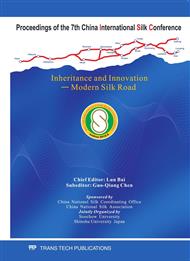p.3
p.8
p.13
p.19
p.25
p.30
p.36
p.41
The Fluorescent Pigment of Mulberry Transferred in the Body of Silkworm, Bombyx Mori
Abstract:
Using silkworm (Bombyx mori, Dazao strain) as material, the fluorescent pigment of mulberry, silkworm blood, silk gland, cocoon shell, silkworm excrement, silkworm urine and moth urine were analyzed by using the technology of thin layer chromatography (TLC). The results indicated that there were 7 bands of fluorescent pigment from the extracts of green cocoon shell after TLC analysis. While, 2 bands in silkworm blood and its urine extracts, 4 bands in the silk gland extracts, as well as 5 bands in moth urine extracts were detected, but no band detection in the silkworm excrement extracts. The blue-violet fluorescent pigment which has the same Rf (0.35) was detected from the extracts of green cocoon shell, silk gland, silkworm urine, moth urine and mulberry after TLC analysis, but it cannot be found in silkworm blood and silkworm excrement. It was revealed that the blue-violet fluorescent pigment may be transferred directly from mulberry leaves, and then accumulated in the silk gland. Most of the pigment remained in the cocoon shell. And only a small amount of this kind of pigment was excreted through urine. There was also some yellow-green fluorescent pigment detected in the silkworm blood, silk gland and cocoon shell extracts, but it cannot be detected in both the mulberry and silkworm urine extracts. It was suggested that yellow-green fluorescent pigment synthesis pathway exist in the body of silkworm (Bombyx mori, Dazao strain).
Info:
Periodical:
Pages:
3-7
Citation:
Online since:
January 2011
Authors:
Price:
Сopyright:
© 2011 Trans Tech Publications Ltd. All Rights Reserved
Share:
Citation:


